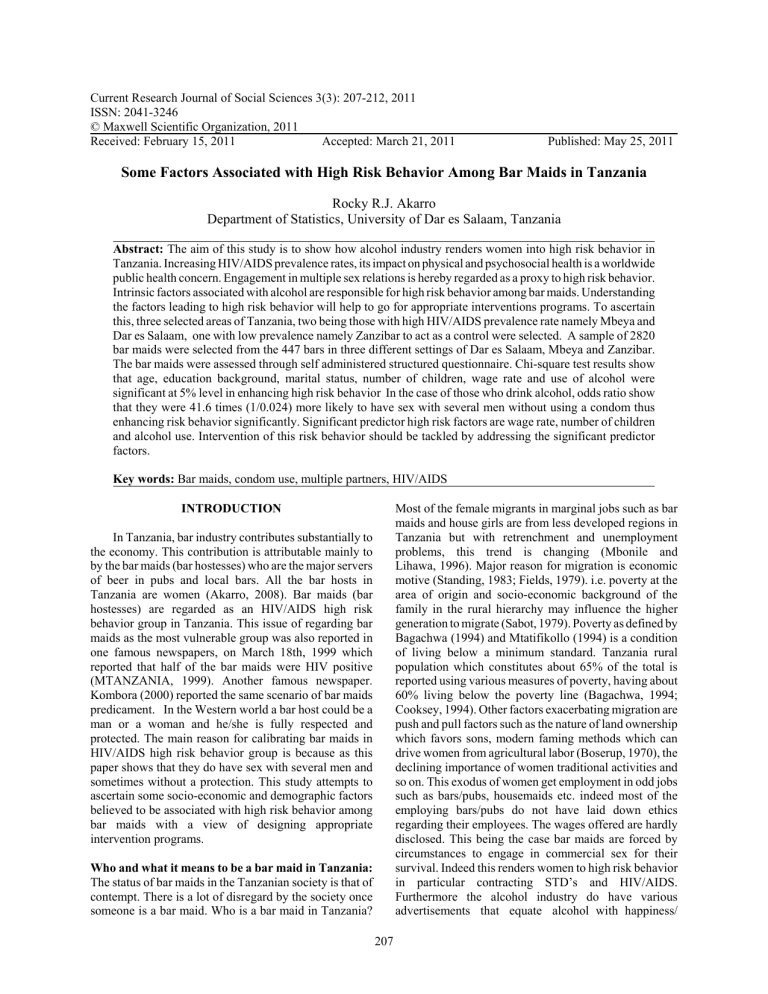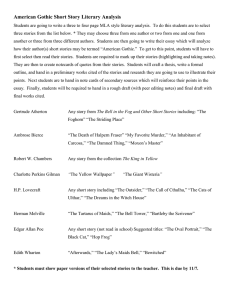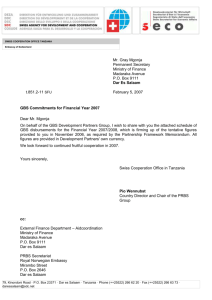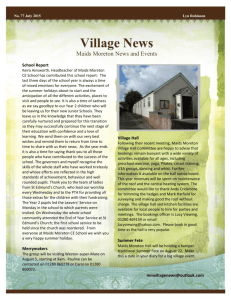Current Research Journal of Social Sciences 3(3): 207-212, 2011 ISSN: 2041-3246

Current Research Journal of Social Sciences 3(3): 207-212, 2011
ISSN: 2041-3246
© Maxwell Scientific Organization, 2011
Received: February 15, 2011 Accepted: March 21, 2011 Published: May 25, 2011
Some Factors Associated with High Risk Behavior Among Bar Maids in Tanzania
Rocky R.J. Akarro
Department of Statistics, University of Dar es Salaam, Tanzania
Abstract: The aim of this study is to show how alcohol industry renders women into high risk behavior in
Tanzania. Increasing HIV/AIDS prevalence rates, its impact on physical and psychosocial health is a worldwide public health concern. Engagement in multiple sex relations is hereby regarded as a proxy to high risk behavior.
Intrinsic factors associated with alcohol are responsible for high risk behavior among bar maids. Understanding the factors leading to high risk behavior will help to go for appropriate interventions programs. To ascertain this, three selected areas of Tanzania, two being those with high HIV/AIDS prevalence rate namely Mbeya and
Dar es Salaam, one with low prevalence namely Zanzibar to act as a control were selected. A sample of 2820 bar maids were selected from the 447 bars in three different settings of Dar es Salaam, Mbeya and Zanzibar.
The bar maids were assessed through self administered structured questionnaire. Chi-square test results show that age, education background, marital status, number of children, wage rate and use of alcohol were significant at 5% level in enhancing high risk behavior In the case of those who drink alcohol, odds ratio show that they were 41.6 times (1/0.024) more likely to have sex with several men without using a condom thus enhancing risk behavior significantly. Significant predictor high risk factors are wage rate, number of children and alcohol use. Intervention of this risk behavior should be tackled by addressing the significant predictor factors.
Key words: Bar maids, condom use, multiple partners, HIV/AIDS
INTRODUCTION
In Tanzania, bar industry contributes substantially to the economy. This contribution is attributable mainly to by the bar maids (bar hostesses) who are the major servers of beer in pubs and local bars. All the bar hosts in
Tanzania are women (Akarro, 2008). Bar maids (bar hostesses) are regarded as an HIV/AIDS high risk behavior group in Tanzania. This issue of regarding bar maids as the most vulnerable group was also reported in one famous newspapers, on March 18th, 1999 which reported that half of the bar maids were HIV positive
(MTANZANIA, 1999). Another famous newspaper.
Kombora (2000) reported the same scenario of bar maids predicament. In the Western world a bar host could be a man or a woman and he/she is fully respected and protected. The main reason for calibrating bar maids in
HIV/AIDS high risk behavior group is because as this paper shows that they do have sex with several men and sometimes without a protection. This study attempts to ascertain some socio-economic and demographic factors believed to be associated with high risk behavior among bar maids with a view of designing appropriate intervention programs.
Who and what it means to be a bar maid in Tanzania:
The status of bar maids in the Tanzanian society is that of contempt. There is a lot of disregard by the society once someone is a bar maid. Who is a bar maid in Tanzania?
Most of the female migrants in marginal jobs such as bar maids and house girls are from less developed regions in
Tanzania but with retrenchment and unemployment problems, this trend is changing (Mbonile and
Lihawa, 1996). Major reason for migration is economic motive (Standing, 1983; Fields, 1979). i.e. poverty at the area of origin and socio-economic background of the family in the rural hierarchy may influence the higher generation to migrate (Sabot, 1979). Poverty as defined by
Bagachwa (1994) and Mtatifikollo (1994) is a condition of living below a minimum standard. Tanzania rural population which constitutes about 65% of the total is reported using various measures of poverty, having about
60% living below the poverty line (Bagachwa, 1994;
Cooksey, 1994). Other factors exacerbating migration are push and pull factors such as the nature of land ownership which favors sons, modern faming methods which can drive women from agricultural labor (Boserup, 1970), the declining importance of women traditional activities and so on. This exodus of women get employment in odd jobs such as bars/pubs, housemaids etc. indeed most of the employing bars/pubs do not have laid down ethics regarding their employees. The wages offered are hardly disclosed. This being the case bar maids are forced by circumstances to engage in commercial sex for their survival. Indeed this renders women to high risk behavior in particular contracting STD’s and HIV/AIDS.
Furthermore the alcohol industry do have various advertisements that equate alcohol with happiness/
207
wisdom. If the management of these alcohol/beer outlets were at the forefront in humanizing bar maids profession, the status of bar maids would probably be different and perhaps the rates of HIV/AIDS would not be that high.
MATERIALS AND METHODS
The population to be considered is the set of bar maids (hostesses). Within this set, there is subset of the demographic and socioeconomic characteristics.
Demographic characteristics included variables such as age, marital status, education level and fertility.
Socioeconomic traits included variables such as sexual relations, condom use, family background and any responsibilities at the household level. Data used in this study were cross sectional in nature obtained from a survey conducted between September 2004 and October
12 th 2005. A sampling procedure was used to select bar maids in Dar es Salaam, Mbeya and Zanzibar. The city of
Dar es Salaam was selected because it is the largest commercial city in the country, with the largest proportion of bars. It is also one of the areas with the highest rates of
HIV/AIDS infection (NACP, 1995).
Mbeya was selected because it is also one of the most affected areas. Zanzibar town was selected because it has a low rate of HIV/AIDS infection.
In 2005 for example HIV prevalence rate for
Tanzania was estimated at 8%. The prevalence rate for
Dar es Salaam was about 12%, Mbeya 14% and Zanzibar
0.6% (http//:www.tanzania.go.tz/hiv_aids.html). The rate for bar maids was estimated at 32% for Moshi
(http//:www.tanzania.go.tz/hiv_aids.html) and 50% in for
Dar es Salaam and Mbeya (Dira, 2008). This selection somewhat took into account the cultural diversity of the areas so as to facilitate identification of any cultural beliefs that may be linked with alcohol consumption. Data collected were on average samples proportional to population sizes of the selected towns. The sample consisted of 262 bars in Dar es Salaam with a sampled population of 1394 bar maids, 129 bars in Mbeya with a population of 1000 bar maids and 56 bars in Zanzibar with a population of 426 bar maids. So the total number of bars selected was 447 and the total number of bar maids interviewed was 2820. The bars selected were both traditional bars selling traditional alcohol and medium to large bars selling factory-made alcohol. This is because the bar maids’ behavior in these two types of bar were assumed to be similar. Tourist hotels were excluded because in order to be employed in a tourist hotel as a bar maid, certificates are necessary. Furthermore, misconduct is usually not tolerated in the tourist hotels.
The sampling design was a two-stage sampling procedure. The first stage involved obtaining a list of all licensed bars. Such a list was obtained from trade offices of the three municipalities of Kinondoni, Ilala and
Curr. Res. J. Soc. Sci., 3(3): 207-212, 2011
Temeke in the case of Dar es Salaam and from respective municipalities in the case of Mbeya and Zanzibar. Such a list was organized under the various wards. A systematic sample of bars was then selected to take into account the number of bars in each ward within the sample. The second stage involved sampling bar maids within the selected bars. If the number of bar maids was small-say four or less-all were selected. Otherwise, a limited number was randomly selected, usually half of the number of bar maids within a particular bar.
Questionnaires were used with less sensitive questions such as characteristics of the respondents asked at the beginning so as to create an atmosphere of trust between the respondents and the researcher. Sensitive questions such as sexual relations, nature of sexual relationship, condom use or non use and reason for condom use were asked later after a thorough acquaintance with the respondents. Their responses were then filled in the questionnaires.
Various variables were considered which were thought to be associated with HIV/AIDS high risk behavior. The variable considered being a reflection or proxy to high risk behavior was having sex with several
(multiple) men. The definition of several (multiple) partners in our context means that while a bar maid may be having a permanent partner she also has one or more partners at the same time. This goes on as long as she is a bar maid (Table 1).
Cross-tabulations of having sex with several men
(multiple partners) by the demographic and socioeconomic variables in categorized forms were done to assess the degree of association.
Since the dependent variable is dichotomous a logistic regression model of the form:
1
−
p )]
α
i n
= + ∑
=
1
β
where p is the probability of a bar maid having sex with several men (multiple partners), a and b i
are estimated regression coefficients, and x i
are the various explanatory variables was used.
An overall test of significance of each independent variable was done using a likelihood ratio test, which is essentially a chi-squared test on the difference in loglikelihoods. For details see, for example, Polissar and
Diehr (1982).
RESULTS AND DISCUSSION
The results in Table 2 show that the five variables namely age, marital status, number of children, education level, whether one drinks or not and wage rate were all
208
Age in years
Marital status
Number of children
Education level
Drinks alcohol
Wage rate (Tanzanian shillings per month)
Curr. Res. J. Soc. Sci., 3(3): 207-212, 2011
Table 1: Definition of the variables used in the analysis
Variable
Multiple partners
Description and coding
The status of a bar maid if she has sex with several men
1: Yes
0: No
1: 10-14
2: 15-19
3: 20-24
4: 25-30
5: Above 30
Marriage status of a bar maid
1: Married
2: Single
3: Divorced
4: Separated
5: Widowed
Number of children the bar maid has
0: None
1: One
2: Two
3: More than two children
1: Nil
2: Incomplete primary education
3: Complete primary education
4: Secondary and above
Whether the bar maid drinks alcohol or not
1: Yes
0: No
Financial remuneration of bar maid
1: Less than 10 thousand
2: 10-15 thousand
3: 16-20 thousand
4: 20-30 thousand
5: Over 30 thousand significant at 5% level (p = 0.000). Analysis shows that
94.9% of the women had sex with several men (multiple partners) and 5.1 did not. The leading group being the singles aged 10-14 years followed by those aged 20-24 years. The leading age group of those who did not have sex with several men is those aged 30-39 years of age and the married.
Similar results were obtained for the relationship between having sex with several men and number of children and education level. We notice that the most regular sex participants are those who have had one child
(49.3%). Perhaps sexual intercourse with several men in this category is a reflection of the upkeep needed to bring up the child. As for education level, analysis shows that most of those who did not have sex with several men are those with secondary education and above. Again there is a difference in perception in having sex with several men among different levels of education and analysis shows that the null hypothesis H
0
that there is no relationship between having sex with other men and education level is rejected (p = 0.000).
Significance relationships is also noted between having sex with several men and the variable drinking alcohol and having sex with several men and wage rate.
Those who drink are also apt to having sex with more men than those who do not drink. This is line with observations from WHO-GENEVA (2008) which showed that alcohol use was a source of promiscuous behavior among women in eight selected countries such as South
Africa, India, Kenya, Mexico etc.
In the case of wage rate, cross tabs show that those earning between 10
G 5 thousand (the lowest wage category) Tanzania shillings (99.2%) is the greatest category who have sex with several men an indication that those in this wage category have sex with several men do so to supplement their incomes. This is in line with Akarro (2007) who showed that a bar maid can negotiate for sex without a condom and given more money a bar maid is willing to have sex without a condom.
Results from multivariate logistic regression analysis for having sex with several men: Having identified significant relationships between having sex with several men and the independent variables, a multivariate logistic regression analysis was done to see the effect of the independent variables on the dependent variable. All independent variables considered showed significant relationships at 5% level with the dependent variable and hence all were entered into the multivariate logistic regression model (Table 3).
The effect of each independent variable is indicated by the odds ratio computed for each variable category relative to the reference category.
209
Curr. Res. J. Soc. Sci., 3(3): 207-212, 2011
Table 2: Relationship between having sex with several men (multiple partners) and other variables
Variable No. of bar maids with multiple sexual partners
Age in years
No. of bar maids not have multiple partners
10-14
15-19
20-24
25-30
Above 30
None
One
Two
More than two
226
593
1556
290
11
P 2 = 127.713
Marital status
Married
Single
Divorced
-
2178
19
Separated 467
Widowed 12
P 2 = 418.123
Number of children
796
1389
361
130
P 2 = 69.319
-
23
62
53
6 p = 0.000
14
79
14
9
8 p
60
27
39
18
= 0.000
p = 0.000
Education level
Nil
Incomplete primary education
Complete primary education
Secondary and above
45
610
1988
33
P 2
= 260.845
10
50
50
28 p = 0.000
Drinks alcohol
Yes
No
2638
38
P 2
= 563.635
90
54 p = 0.000
Wage rate (in Tanzanian shillings per month)
Less than 10 thousand
10-15 thousand
16-20 thousand
20-30 thousand
Over 30 thousand
6
2467
98
89
16
P 2 = 814.351
4
20
50
56
14 p = 0.000
The multiple logistic regression results from Table 3 shows that when the individual variables are included in the multiple regression analysis, the predictor variables of having sex with several men are number of children, wage rate and drink alcohol status. Marital status, age in years and education are insignificant. Though marital status is insignificant, the odds ratio for singles is amazingly high. This is not surprising since the reference category for the marital status were the married who hardly have sex with other men apart from their spouses.
This very big figure is an indication that the singles were more likely to have sex with several partners in comparison to the married women.
In the case of those who drink alcohol, odds ratio show that those who drink are 6.5 times (1/0.152) more likely to have sex with other men in comparison to those who do not drink. In other words alcohol is a factor in a risky behavior for the bar maids. This is in line with
WHO-GENEVA (2008) who observed a contribution of risky behavior in eight countries was manifested by use of alcohol.
The most serious reflection of risk behavior when bar maids have sex with several men is that condom is not used at all times and given more money a bar maid can negotiate for sex with someone without using a condom.
Akarro (2007) has shown that bar maids who on average use condom always are only 2.2%. This figure can be interpreted as bar maids who use a condom for the prevention of HIV/STD’s are only 2.2%. Furthermore the same study by Akarro (2007) shows that 90.7% of the bar maids can negotiate for sex without a condom if given more money.
In the case of number of children, we notice that women at all levels irrespective of the number of children have sex with several men. This may partly be explained by poverty levels in a sense that subsidy from an external source (most probably a man) is needed for the upkeep of the children. Those with no children are 1.8 times less likely to have sex with other men in comparison to those with two children and above. This may partly be explained by the fact that those with no children are in the process of looking for the prospective husbands wage rate differences play a role in predicting risk behavior of bar
maids. Those earning 10-15 thousand shillings show
a significant categorical contribution (p = 0.000) and they are 38(1/0.026) times less likely not to have sex with
210
Curr. Res. J. Soc. Sci., 3(3): 207-212, 2011
Table 3: Estimated multiple logistic regression equation for multiple partners
Variable Coefficient SE
Age in years
10–14
15–19
20–24
25–29
- 6.290
- 0.437
0.150
- 0.176
30–39 Ref.
Education
Nil
Primary incomplete
Primary complete
- 1.024
0.376
- 1.453
10.968
0.918
0.842
0.737
0.336
0.563
0.388
0.400
p-value
0.501
0.566
0.634
0.858
0.811
0.069
0.332
0.257
Secondary Ref.
Marital status
Married Ref.
Single 10.537
Divorced
Separated
Widowed
- 0.781
0.268
- 0.783
Number of children*
None
One
Two
More than two
0.638
- 0.700
- 0.101
Ref.
Drinks alcohol*
Yes - 1.881
No Ref.
0.235
—
40.758
0.573
0.685
0.630
0.001
0.542
0.544
0.464
0.000
0.315
0.796
0.173
0.696
0.214
0.239
0.198
0.828
0.000
Wage rate*(T shs)
Less than 10 thousand
10–15 thousand
16–20 thousand
- 1.140
- 2.947
- 0.705
0.000
0.879
0.534
0.506
0.774
0.000
0.217
21–30 thousand
Over 30 thousand
- 0.367
Ref.
0.480
0.912
Constant
Model
P
0.579
= 578.474, p = 0.000; degree of freedom (df) =19; number of cases ( n ) = 2820; *: Significant at 1% level
RECOMMENDATION other men in comparison to those earning 30 thousand shillings or more.
In the case of wage differences, treating those earning over 30 thousand shillings as a reference category
(Table 3), we notice that those earning less than 10 thousand shillings are 1.3 times less likely not to have sex for money while those earning 10-15 thousand shillings
(who are the majority) are about 110 times more likely to have sex for money.
CONCLUSION
Odds ratio
0.002
0.646
1.162
0.839
1.000
0.359
0.686
0.636
1.000
37692.818
0.458
1.307
0.457
1.892
0.497
0.904
1.000
0.152
1.000
1.273
0.026
0.534
0.948
1.000
There is there a need for the government to look into the wage structure of the bar maids and age at which they get employed. There should be deliberate move to discourage the employment of underage bar maids. There should be a deliberate move to have more attendants who are men on the assumption that women will not follow the male attendants because Tanzanian culture discourages such behavior.
There is also a need for media involvement in promoting the idea of discouragement of irresponsible drinking and educating women on the dangers of having unwanted babies.
From epidemiological point of view bar maids are in a HIV/AIDS high risk category in contracting and transmitting HIV/AIDS. This is because they have sex indiscriminately with several men and without using a condom at all times.
The significant high risk factors are wage rate, number of children and alcohol drinking. Coupled with the hardies of life and ignorance of the disease, bar maids can negotiate for sex without a condom. It seems that the majority of bar maids with the exception of those aged
10-14 years are knowledgeable on condom use. However, bar maids at all levels can negotiate for sex without a condom if given more money thus rendering them in a high risk category in contracting and spreading
HIV/AIDS.
ACKNOWLEDGMENT
The author acknowledges Sida/SAREC for funding the initial research which is the source of data used in the study.
REFERENCES
Akarro, R., 2007. Factors influencing the sexual behavior of bar maids and their relations with HIV/AIDS
Spread in Tanzania. Unpublished Research Report,
Faculty of Arts and Social Sciences, University of
Dar es Salaam.
211
Curr. Res. J. Soc. Sci., 3(3): 207-212, 2011
Akarro, R., 2008. The use of the bar industry as an accelerator for HIV/AIDS spread in Tanzania. Eur. J.
Soc. Sci., 6(1).
Bagachwa, M.S.D., 1994. Poverty Alleviation in
Tanzania. Recent Research Issues. Dar es Salaam,
Dar es Salaam University Press.
Boserup, E., 1970. Women’s Role in Economic
Determinant. Allen and Unwin, Londin.
Cooksey, B., 1994. Who’s Poor in Tanzania. A Review of
Recent Poverty Research. Bagachwa, M.S.D. (Ed.),
Poverty Alleviation in Tanzania: Recent Research
Issues. Dar es Salaam University Press, Dar es
Salaam, pp: 57-90.
Dira, 2008. One of the famous daily newspapers of
Tanzania of 20 th - 26 th May.
Kombora, 2000. A Weekly Newspaper that Appeared. Jan
14 th - 20 th .
Fields, G.S., 1979. Lifetime migration in columbia. Test of the expected income hypothesis. Popul. Dev. Rev.,
5(2): 247-265.
Mbonile, M.J. and H.A. Lihawa, 1996. Rural-Urban
Migration in Tanzania. A case os Dar es Salaam,
UTAFITI (New Series). Journal of the Faculty of
Arts and Social Sciences, University of Dar es
Salaam.
MTANZANIA, 1999. A Daily Newspaper in Tanzania.
18 th March.
Mtatifikollo, F., 1994. Resources for Human
Development. Tanzania Report to UNFPA, Dar es
Salaam, UNFPA.
National AIDS Control Program (NACP), 1995.
HIV/AIDS Surveillance. Ministry of Health, Report
No. 10.Tanzania mainland, 1995.
Polissar, L. and P. Diehr, 1982. Regression analysis in health services research: The use of dummy variables. Medical Care, 20(9): 959-966.
Sabot, R.H., 1979. Economic Development and Urban
Migration in Tanzania. 1900 -1971. Clerendon Press,
Oxford.
Standing, G., 1983. Population Mobility and Labour
Process. United Nations Population, Migration and
Development, New York.
WHO- GENEVA, 2008. Alcohol Use and Sexual Risk
Behaviour: A Cross- Cultural Study
Ineightcountriesat. Retrieved from: http://www.who.
int/substance_abuse/publications/alcohol_sexual_ri sk_crosscultural.pdf, (Accessed on: 4 December,
2008).
212




